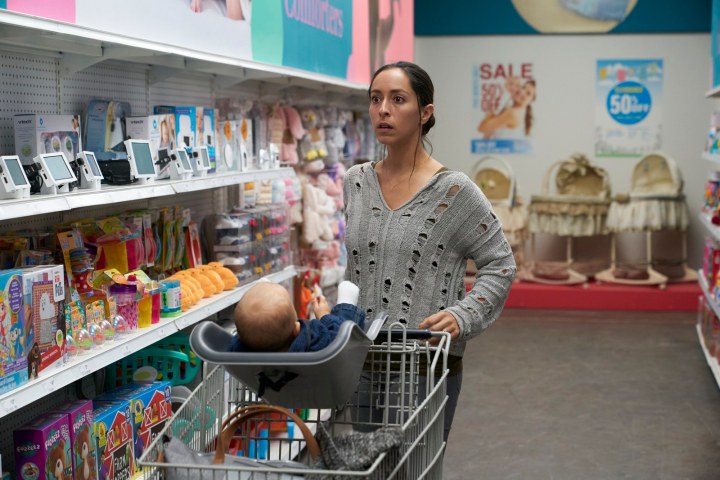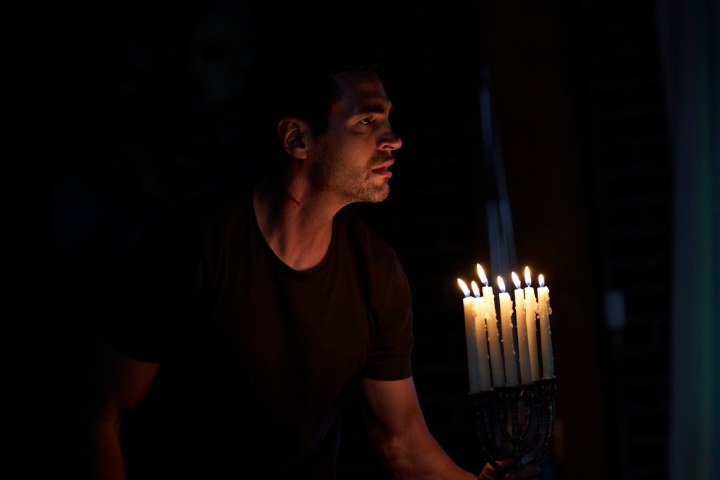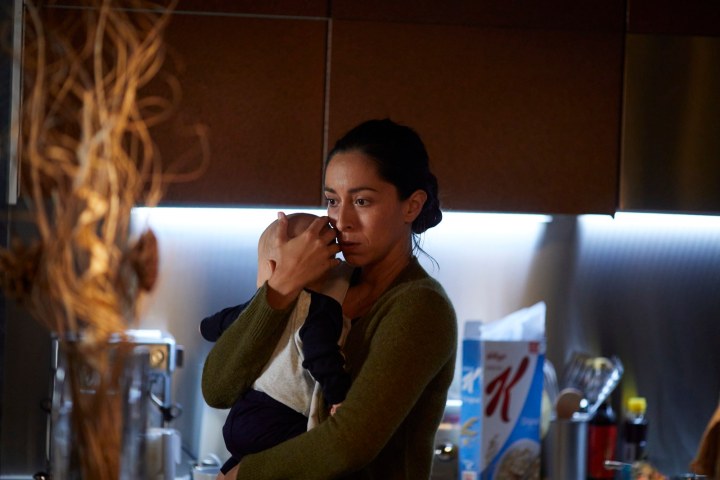John Leonetti understands how to scare an audience. The veteran cinematographer shot some of the most memorable horror films of the 2010s, including Insidious, The Conjuring, and Insidious: Chapter 2. This partnership with James Wan, who directed all three of those films, led to Leonetti stepping into the director’s chair for Annabelle, which grossed over $255 million on a $6 million budget. Leonetti’s not-so-secret strategy for success involves using as little CG as possible, which the stars of his latest movie, Lullaby, appreciate.
In Lullaby, Rachel Schoenberg (Avatar’s Oona Chaplin) and John Guerrero (The Affair’s Ramón Rodríguez) are recent parents struggling to adjust to life with their newborn son, Eli. After six months, the sleep-deprived couple is desperate for solutions on how to stop their baby from crying. Rachel stumbles upon a Hebrew book sent by her mother and sings the lullaby found on one of the pages, which makes the baby fall asleep. Unbeknownst to Rachel, the lullaby summons Lilith (Women Talking’s Kira Guloien), a mythological creature who steals babies from their parents. When Lilith commands her demons to kidnap Eli, Rachel and John must fend off the evil creatures to save their baby’s life.
In an interview with Digital Trends, Leonetti, Chaplin, and Rodríguez discuss religious mythology and describe the creepiest elements of Lullaby. They also share their thoughts on why the parental relationship, not the horror, is the driving force in Lullaby.

Note: This interview has been edited for length and clarity.
Digital Trends: With any horror film, I like to ask the people involved if they ever get scared on set. Were there moments you had to look away or take a step back because it was too scary?
John Leonetti: Not really. I wanted to create that harmonic thing that makes you move to the front of your seat, or the hair [standing] on your back or neck, or your skin tingle. That, to me, is having to go to a dark place in our minds psychologically. But I never really get scared. It’s funny. The depth of horror and the supernatural and how it messes with the mind is more intriguing to me than scary.
Oona Chaplin: No. There were a few moments that were absolutely horrific. The mirrored hallway, the exploding mirrors, my nervous system was shot after that. It was just so stressful and scary. There were a couple of moments with the hag where I genuinely didn’t know where she was, but I was like, “Ah.” [Laughs]
That would freak me out. Do you enjoy horror films? Were you interested in horror as an actor?
Chaplin: I like making them. [Laughs] I don’t like watching them. I can’t because they just haunt me for too long. It’s too much.
Ramón, I read in the notes that you’re not a big horror person. You cited The Exorcist as the film that scared you.
Ramón Rodríguez: Yeah, The Exorcist was one that stayed with me. Those classic old-school ones like The Exorcist and The Omen. There was just something about them, maybe it’s due to my Catholic upbringing, that felt like, “Oh, this could happen, and that’s scary.” I think that’s sort of what kind of drew me to Lullaby. It’s based on some mythology, and it incorporated some Judaism. It felt creepy on the page, and I’d never done it before, so I try to keep myself excited and challenged by projects.

John, were you familiar with any ancient Hebrew mythology before going into this project?
Leonetti: I didn’t know much about it. I just read the script, and was immediately interested. I just love the fact that she was the first woman before Eve, supposedly. She was in the Talmud, not the Torah, but that mythology is there. It opens up a whole world. The fact that she was equal to Adam, and yet banned by God and Adam to not have natural babies was a really awesome conflict, I thought.
I was raised Catholic, and almost all the movies that we see are Judeo-Christian mythology. The fact that this was Hebrew, ancient Hebrew, which is really before Jesus was born, was very interesting to me. I didn’t know anything, but I’ll tell you, it was great jumping into it.
What did you discuss in your initial meetings with John leading up to the project?
Chaplin: We had a really good plate of spaghetti at a really good Italian place. I think we talked about motherhood, and we talked about how he likes to make movies, which is doing basically as much on the set and as little on CGI as possible. That really appealed to me.
Rodríguez: It was great to see his track record in horror. That gave me a lot of confidence, especially since I haven’t done it. We’ve got a leader that has done this and knows how to create suspense and tension. First of all, he’s been in the business so long, right? He’s a cinematographer and he’s just done such great work. I love that he wanted everything to be very much in-camera. He didn’t want to use a lot of special effects or stuff. That’s a great element.
As an actor, it’s nice when you can act with the thing that you’re supposed to be acting along with. He’s got such a chill vibe, but he’s very clear as to what he wants. He showed me early mock-ups of ideas. It was a real collaborative process, and we had a lot of discussions about this couple and the newborn baby and what that’s like, and how this little creature starts entering their world and really messing with them.
Rachel and John’s relationship is at the center of this story. What were you looking for in the actors when casting these roles, and how did you eventually decide on Oona and Ramón?
Leonetti: Well, again, it wasn’t about getting stars. It’s about just really good actors, and that’s always the case, in my opinion, in any movie. Even though to get movies financed, you need a name. That’s a whole other part of the business. But again, I just wanted them to be very relatable and real. That’s the premise.
I saw Oona on a couple of episodes of Game of Thrones, and she was so genuine to me. She was just so real in that part, and it was powerful. So I think that’s what stood out at first. I met her, and she seemed real and nice.
With Ramón, he’s a really good actor, [but] I didn’t know anything about him. He was presented to me, and I went, “Oh, wow. This guy is so likable. He’s just so likable.” And the fact that he was Latino, and came from probably a Catholic background that converts, is very real and relatable. It broadens the audience’s feeling for reliability. Then I met him, and what an amazingly nice guy and talent he is.
I think what really sold it to me is when we did a three-way FaceTime call, I just saw how they kind of jive. They’re both very professional. They’re really good actors.
The heart of the film is about two first-time parents and the struggles of raising a child. Rachel comes from a successful business career and is thrust into motherhood. It’s a sink-or-swim moment. How did you channel those feelings of uncertainty when it comes to motherhood? Did you draw inspiration from anyone in your life or from other movies?
Chaplin: Well, I have very successful female friends that have incredible careers. Then, they’re given the task of being mothers, and they lose their shit. [Laughs] You see they’re all frazzled, just trying to just get [the baby] to go to the bathroom. This becomes a whole ordeal. I’ve also seen extremely skillful mothers that have an incredible gifts. It was interesting to feel that challenge, especially because the babies [on set] wouldn’t cry.
Oh wow. You had two good babies.
Chaplin: They were having the time of their lives, and they wouldn’t cry, so it was definitely challenging. The thing about a successful career is that it’s about problem-solving, and problem-solving is something that is about control, right? Generally speaking, businesspeople have a certain amount of control, and the more that they can control and plan, the better. You can’t control another human being. People try to all the fucking time, and it is an exercise in futility because all it creates is unhealthy dynamics.
You can’t control another human being, especially a human being that doesn’t understand manipulation, like a baby. It brings up a whole other side of our lives, and especially as women that have so much pressure to have a successful career. There’s not a lot of good mother-making in this world, and if we don’t have good mothers, then what kind of future do we have for the world?
It was beautiful to navigate in that in that place, facing the challenges of very, very real things that should come naturally and should be taught how to do. We’re not, so it was interesting.

John is trying to do whatever he can to support his wife. How did you channel those thoughts about faith and love into this performance?
Rodríguez: Yeah, that’s what really connected with me. I’m going to look for the human aspect in this story, and I thought it was intriguing, what that must feel like to be a new parent with your baby and your wife begins to lose it, and you’re not sure what’s going on. Then, you start to lose it, and you begin to doubt and question things.
In his backstory, he’s someone who converted to Judaism for his wife. That informed me a lot as to how much this person loves his wife and what he’s willing to do for her. I like that we, and that was always on the page as well, that we could incorporate that he might have not been the firmest believer in Judaism, because he really just did it for marriage, for love. He had to become a believer to ward off the crone and try to save his family.
For more than half the film, your only interactions are with each other and your child. What did you do behind the scenes to build a believable relationship in a short amount of time?
Chaplin: Man, that relationship was like that from the start. It was amazing. We had one Zoom call, and we just clicked. We talked about relationships, I think, and we talked about the script. We didn’t have time to go into all the things that we wanted to go into because we had to do costume fittings, etc. But instantly I was like, “Oh, this is going to be a treat. Like, we’re good.” Because of the COVID paranoia that everybody was in, we didn’t actually get to hang out at all outside of the set. We weren’t allowed to.
Rodríguez: It was COVID, and we were all holed up in our home separately. What I actually loved about is we all had to arrive there at least two weeks early to quarantine. That gave you at least two weeks to sort of prepare, and I had already been preparing. We got on several Zoom calls to have a lot of conversations about this couple and what they’ve been through, what they do as careers, and how they function with each other now. How do they function with this new baby coming into their lives?
Oona was just really great and generous. We had a blast making it, and we just got to spend a lot of time primarily on Zoom. And then when we were on set, we would just talk constantly and say, “OK, what do we think about this situation?” We had real babies to work with as well. They’d bring in these babies, twins that you’re sort of swapping out. It’s a wild thing to imagine your baby being attacked by something that you don’t really know. It’s pretty terrifying.

Reading about the film, you stressed the importance of keeping the movie as grounded in reality as possible. You try and use as many in-camera effects as you can. John, why do you choose to go that route in your films?
Leonetti: Honestly, I’ve always felt that way. Well, the first movie I did with James [Wan], Dead Silence, was a little more theatrical, and the look of it was a little more stylized even in terms of the amount of skip bleach we did in the coloring, but it still was grounded. However, since then, starting with Insidious, that changed.
You shoot the story and you light the whole place so that you are able to go anywhere. You make the lighting, which I really honed on Insidious and developed further in The Conjuring, very natural. I’ve always come from the place where the more natural and believable the look of a film is, then the scarier it is. It’s that simple.
That’s true for Lullaby and the way it looks. I just happened to be an advocate, and kind of an expert, on using “ghost glass,” which splits beams of light. When I read the script, I immediately went, “Oh my God. How much fun is this going to be?” We [used] the light to balance the foreground and background.
Using a beam splitter, which is translucent and reflective, you can balance with light and make things disappear and appear. But it’s in-camera, and the actors can see the effect themselves. They can see each other in camera. It’s got a green screen effect, so it’s very much real, and I think it’s effective.
What was the creepiest element of this film?
Rodríguez: I thought the crone was pretty creepy. She did a wonderful job, that actress [Mary Ann Stevens]. The makeup department and the effects, everything they did for her, she just looked really, really creepy. And that kind of stayed with me for a little while.
Chaplin: The two-headed baby was definitely horrible. Not nice to be around. I feel like the ocean of dead babies was pretty bad, too. There was an ocean of dead babies that they spray painted black, so there was that.

John really likes to do stuff in reality.
Chaplin: That’s what he’s about. That’s what I love about him. I’m just like, “Wow, this guy, he’s going at it, and he wants the frigging full experience of this horrible thing.” I want him to make a really amazing fantasy film. Do it the same way.
The deformed babies crawling out of the closet was the creepiest scene for me. How did you decide on the look for those babies?
Leonetti: You know, it wasn’t easy. Basically, we were only going to have two of them. We can only afford to have two of them because [of] the budget. They’re full CG critters, of course. The congenital twins deal, to me, that’s just creepy. Yet the essence of both, them and the little wolf-fucker we call him, they both have to be believable as part human babies of that age. That was the ground floor for designing these things.
I think the wolf guy was because she was thrown to the wolves. It hit me like, “Well, OK. That’s half a wolf and a half human.” To have conjoined twins with three arms and four legs, it’s just weird ass shit. It’s creepy. That’s basically how we did it. You just imagine it, and you have to know where they are in the frame. You pan the camera, and they’re not there out there, like any kind of a full CG scenario in a live set. So that was basically it.
Lullaby is available on demand and in select theaters on December 16.
Editors' Recommendations
- The best kills in John Wick: Chapter 4, ranked
- Shay Hatten on the secret to writing John Wick: Chapter 4
- Can John Luther kick James Bond’s ass? The Fallen Sun’s creators weigh in on the debate
- Ine Marie Wilmann and Pål Sverre Hagen discuss their Norwegian thriller series Furia
- Swallowed cast and director on adding a new viewpoint to body horror films




